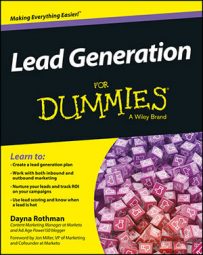The best marketing plans are created with measurements in mind before the program has even been executed. And yes, all of your lead-generation programs are indeed measureable. Even the channels you might have a tough time measuring initially, like social, can be measured. For instance, want to beef up your Facebook presence? How about measuring shares or likes? No matter what your metrics are, know what they are early in the planning process.
Ask yourself the following questions:
What will you measure?
When will you measure?
How will you measure?
So how do you start thinking about making programs measureable?
Create obtainable goals
One of the first elements to keep in mind is to make your goals attainable. Start small, think big, and work quickly. This means don't overdo it. If your company has never created a Twitter account, gaining 100,000 followers in the first 6 months and tweeting 10 times a day might not be realistic.
Consider the following items before you determine your goals:
How much effort do I want to put into each channel/tactic?
How many resources can I assign to making each channel/tactic a success?
How much budget do I have to create programs this quarter/this year?
How much time do I want to spend on each channel/tactic?
From there, you can determine how aggressive your goals are. Then commit to and forecast these metrics and report out on them.
Measure in a marketing automation platform
You can track some metrics without a marketing automation platform. Your CRM (customer relationship management) tool probably has some basic metrics, your email service provider might have a few things, and you can do some calculations manually. However, to truly track your campaigns and tie them to revenue, you need a marketing automation platform that can tie programs to opportunities, pipeline created, and revenue. The more sophisticated your metrics are, the more marketing can be taken seriously, and the more budget you get for next year!
Here is a selection of the types of metrics you can measure with marketing automation:
Program analysis: Proves the effectiveness of your programs and to see what delivers the most ROI (return on investment).
Reporting: Create your own reports that can measure pipeline generated per program, ROI by channel, costs per new name per channel, revenue per program channel, and more.
Opportunity influence: Know what programs affected which deals along the deal lifecycle.
Attribution: See which campaigns generated the initial lead from a closed/won deal and see which campaigns influenced that deal over its lifecycle.
By leveraging the reporting functionality within your marketing automation tool, you can generate more accurate numbers and really show that program attribution that your execs crave.
Build a revenue modeler
You want an overall vision of your funnel, so you can map your buyer journey, define the stages of your company's sales funnel, and know where any given lead is at any given time. Marketing software programs enable you to create a model of your revenue cycle directly in the application, so you can dig deep into each stage to determine how many leads live there, what the leads in each stage look like, how long a lead typically stays in each stage, and what the trends are over time. This type of insight gives you a true foundation for marketing analysis and forecasting because you are starting with a complete picture.

